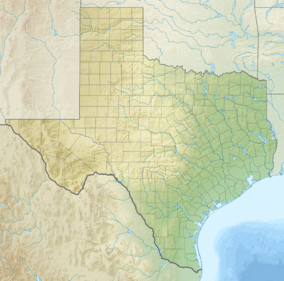Not to be confused with Devil's Kitchen Sinkhole.
| Devil's Sinkhole State Natural Area | |
|---|---|
 Interior view of Devil's Sinkhole Interior view of Devil's Sinkhole | |
  | |
| Coordinates | 30°3′8″N 100°6′12″W / 30.05222°N 100.10333°W / 30.05222; -100.10333 |
| Area | 1,859.7 acres (752.6 ha) |
| Established | 1985 |
| Governing body | Texas Parks and Wildlife Department |
| U.S. National Natural Landmark | |
| Designated | 1972 |
Devil's Sinkhole State Natural Area is a natural bat habitat near the city of Rocksprings in Edwards County in the U.S. state of Texas. Carved by water erosion, the cavern is home to several million Mexican free-tailed bats that emerge at sunset during April through October.
History
The Devil's Sinkhole is a vertical natural bat habitat. The 40-by-60-foot (12.2 m × 18.3 m) opening drops down to reveal a cavern some 400 feet (122 m) below.
While likely known to native peoples, the cavern was first discovered in modern times by Ammon Billings, a local rancher leading a scouting party of five, west of Hackberry Creek in Edwards County in 1876. Billings fired at a marauding party of hostile Indians and believed he hit one. Fearing a trap, they did not pursue the Indians but returned to the area the following day, May 21, 1876 with their spouses. It was then that the sinkhole was first encountered by Ammon Billings. Billings wife, Lucinde Katherine Billings (née Stroop) and other wives in the returning party dubbed the sinkhole "The Devil's Sinkhole".
H. S. Barber carved his name inside the cave in 1889. In 1968, the Devil's Sinkhole was designated as a National Natural Landmark by the National Park Service.
The area was transferred to the state of Texas in 1985, and opened to the public in 1992.
Facilities, admission
Access to the area is available only through advance reservations. Evening bat flight tours are offered in summer only. Guided nature hikes are also available.
Facilities include a wheelchair-accessible viewing platform and picnic areas. With reservations, tours are conducted by the Devil's Sinkhole Society, a local volunteer group that works in conjunction of Texas Parks and Wildlife Department and Bat Conservation International to facilitate visitor education and tours.
See also
- List of museums in Central Texas
- List of sinkholes of the United States
- National Register of Historic Places listings in Edwards County, Texas
References
- Parent, Laurence (2008). Official Guide to Texas State Parks and Historic Sites: Revised Edition. University of Texas Press. pp. 2, 3. ISBN 978-0-292-71726-8.
- "Clipped From Kerrville Mountain Sun". Kerrville Mountain Sun. August 25, 1949. p. 15. Retrieved January 1, 2022.
- "Devil's Hole Was Once Considered A Sacred Location In Texas, And Visitors Will Love Its Modern-Day Tours". TheTravel. November 16, 2021. Retrieved December 31, 2021.
- "About – Devil's Sinkhole". Retrieved December 31, 2021.
- "TSHA | Devil's Sinkhole". www.tshaonline.org. Retrieved December 31, 2021.
- Smith, A. Richard. "Devil's Sinkhole discovery". Handbook of Texas Online. Texas State Historical Association. Retrieved February 11, 2012.
- "National Natural Landmarks - National Natural Landmarks (U.S. National Park Service)". www.nps.gov. Retrieved March 27, 2019.
Year designated: 1972
- ^ "TPWD Devil's Sinkhole". Texas Parks and Wildlife Department. Retrieved August 19, 2018.
- "Tour Information". The Devil's Sinkhole Society. Archived from the original on August 4, 2011. Retrieved February 11, 2012.
External links
- Bat Conservation International
- TPWD Devil's Sinkhole official site
- Texas Power Coop - To the Bat Cave
| National Natural Landmarks in Texas | |
|---|---|
| |
| List of National Natural Landmarks in Texas |